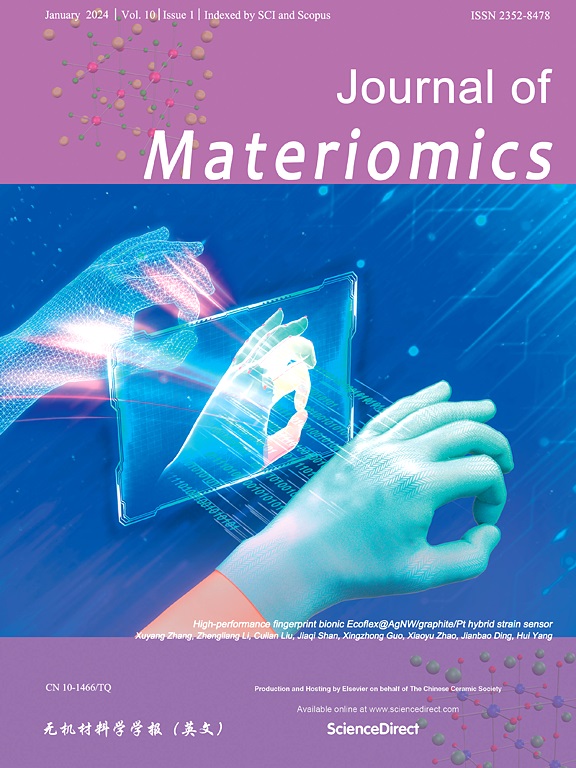低损耗高熵(Mg1/2Zn1/2)0.4+Li0.4(Co1/2Ni1/2)0.4-Al2O4 陶瓷的可调微器介电特性
IF 8.4
1区 材料科学
Q1 CHEMISTRY, PHYSICAL
引用次数: 0
摘要
本研究通过固态反应方法制备了高熵 (Mg1/2Zn1/2)0.4+xLi0.4(Co1/2Ni1/2)0.4-xAl2O4 (x = 0.00-0.40) 陶瓷。这种高熵陶瓷呈现出具有短程局部无序和长程结构有序的尖晶石结构。Co2+ 和 Ni2+ 含量的降低抑制了原子振动的阻尼行为,促进了结构有序化,有助于提高品质因数(Q×f)。在 1550 °C 下烧结的 x = 0.35 样品具有很好的微波介电性能:介电常数(εr)低至 7.92,品质因数高达 135,525 GHz,共振频率温度系数(τf)为 -49 × 10-6 ℃-1。εr值由极化率和相对密度共同决定。Q×f 值主要与相对密度、原子振动和共价程度有关。τf 值与键强度高度相关。这些研究结果表明,采用高熵成分设计能有效地显著改善微波介电性能。本文章由计算机程序翻译,如有差异,请以英文原文为准。

Tunable microware dielectric properties of high-entropy (Mg1/2Zn1/2)0.4+xLi0.4(Co1/2Ni1/2)0.4-xAl2O4 ceramics with low loss
In present study, high-entropy (Mg1/2Zn1/2)0.4+xLi0.4(Co1/2Ni1/2)0.4–xAl2O4 (x = 0.00–0.40) ceramics were fabricated via the solid-state reaction approach. The high-entropy ceramics exhibited a spinel structure with short-range local disorder and long-range structural order. The reduction of Co2+ and Ni2+ content suppress the damping behavior of atomic vibrations, promoting the structural ordering and contributing to higher quality factor (Q×f). The x = 0.35 sample with sintering at 1550 °C exhibited great microwave dielectric properties: a low dielectric constant (εr) of 7.92, a high-quality factor of 135,525 GHz, and a temperature coefficient of resonance frequency (τf) of −49 × 10−6 °C−1. The εr value was jointly dominated by both polarizability and relative density. The Q×f value was primarily connected to relative density, atomic vibrations, and the degree of covalency. The τf value was highly associated with the bond strength. These findings demonstrate the effectiveness of adopting high-entropy composition design for significantly improving microwave dielectric properties.
求助全文
通过发布文献求助,成功后即可免费获取论文全文。
去求助
来源期刊

Journal of Materiomics
Materials Science-Metals and Alloys
CiteScore
14.30
自引率
6.40%
发文量
331
审稿时长
37 days
期刊介绍:
The Journal of Materiomics is a peer-reviewed open-access journal that aims to serve as a forum for the continuous dissemination of research within the field of materials science. It particularly emphasizes systematic studies on the relationships between composition, processing, structure, property, and performance of advanced materials. The journal is supported by the Chinese Ceramic Society and is indexed in SCIE and Scopus. It is commonly referred to as J Materiomics.
 求助内容:
求助内容: 应助结果提醒方式:
应助结果提醒方式:


